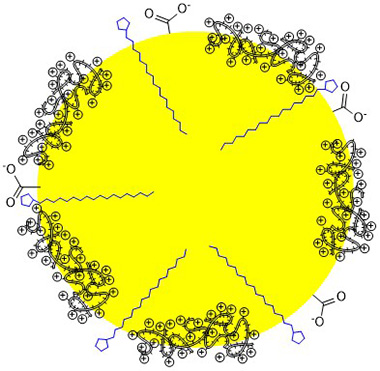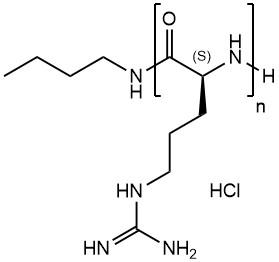Polyarginines are well known for their ability to enhance cell penetration.
Other applications include the formation of PolyArg nanocapsules and the mediation of peptide–carbon nanotube interactions. Polyarginine also has been shown to inhibit protein aggregation. Whatever your desired application, Iris Biotech provides well-defined Polyarginines.

Schematic representation of a Polyarginine nanocapsule composed of an oleic acid core (yellow), surfactant(s) (blue) and polyArg (adapted from Niu et al., J. Control. Release 2017).
→ You will find Polyarginines of different lengths (20 to 200 units) in our webshop.
→ Do you require different functionalities on your Polyarginine, or another chain length? Inquire for a custom-made product.
→ While you are there, why not look through our extensive selection of Polymeric Carriers, including various other polyamino acids, mono- and polydisperse PEGs, as well as polyoxazolines?
References:
- Rational design of polyarginine nanocapsules intended to help peptides overcoming intestinal barriers; Z. Niu, E. Tedesco, F. Benetti, A. Mabondzo, I. M. Montagner, I. Marigo, D. Gonzalez-Touceda, S. Tovar, C. Diéguez, M. J. Santander-Ortega and M. J. Alonso; Journal of Controlled Release 2017; 263: 4-17. doi:https://doi.org/10.1016/j.jconrel.2017.02.024
- Tau peptides and tau mutant protein aggregation inhibition by cationic polyethyleneimine and polyarginine; K. Nadimidla, T. Ismail and M. Kanapathipillai; Biopolymers 2017; 107: e23024-n/a. doi:10.1002/bip.23024
- LPS Cooperates with Poly-L-Arginine to Promote IL-6 and IL-8 Release via the JNK Signaling Pathway in NCI-H292 Cells; L.-L. Zhang, B. Chen, X.-Y. Fan, S.-S. Wu, S.-Q. Zhang and H.-M. Wu; Journal of Immunology Research 2016; 2016: 7. doi:10.1155/2016/3421060
- Delivery of lactoferrin to cells using biodegradable microcapsules; O. Y. Kochetkova, M. M. Yurinskaya, L. I. Shabarchina, A. V. Suslikov, A. A. Naumov, S. A. Tikhonenko and M. G. Vinokurov; Russian Journal of Bioorganic Chemistry 2016; 42: 300-304. doi:10.1134/s1068162016020072
- Preparation of cell-permeable Cre recombinase by expressed protein ligation; S. K. Lyu and H. Kwon; BMC Biotechnology 2015; 15: 7. doi:10.1186/s12896-015-0126-z
- Role of Arginine in Mediating Protein–Carbon Nanotube Interactions; E. Wu, M.-O. Coppens and S. Garde; Langmuir 2015; 31: 1683-1692. doi:10.1021/la5043553
- Vesicular disruption of lysosomal targeting organometallic polyarginine bioconjugates; A. Gross, H. Alborzinia, S. Piantavigna, L. L. Martin, S. Wolfl and N. Metzler-Nolte; Metallomics : integrated biometal science 2015; 7: 371-384. doi:10.1039/c4mt00255e
- Poly-l-arginine based materials as instructive substrates for fibroblast synthesis of collagen; H. C. Bygd, D. Akilbekova, A. Muñoz, K. D. Forsmark and K. M. Bratlie; Biomaterials 2015; 63: 47-57. doi:https://doi.org/10.1016/j.biomaterials.2015.05.045
- Polyarginine nanocapsules: a new platform for intracellular drug delivery; M. V. Lozano, G. Lollo, M. Alonso-Nocelo, J. Brea, A. Vidal, D. Torres and M. J. Alonso; Journal of Nanoparticle Research 2013; 15: 1515. doi:10.1007/s11051-013-1515-7
- Polyarginine Molecular Weight Determines Transfection Efficiency of Calcium Condensed Complexes; N. A. Alhakamy and C. J. Berkland; Molecular pharmaceutics 2013; 10: 1940-1948. doi:10.1021/mp3007117



